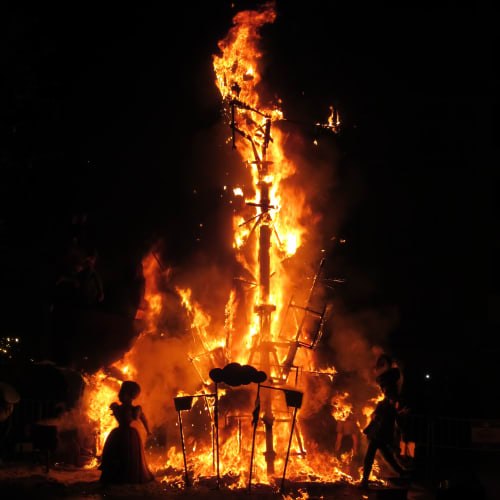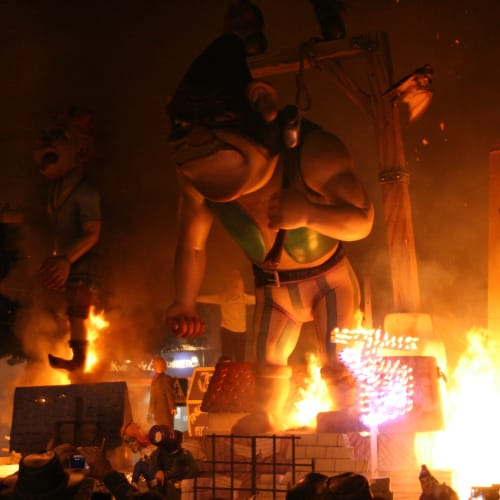Three Kings Sale - Up to 40% Off! Shop Sale
The Thrill of Las Fallas
April 2007




Dear Friends of La Tienda,
Valencia was my first port of call as a young Navy chaplain (and newlywed). Every chance I got I would leave the ship and stroll the cobble-stoned streets of the Gothic Quarter. I liked catching glimpses of what life in the historic port of Valencia has been for centuries. Our young sailors, members of the crews of my destroyer squadron, explored the waterfront - as mariners have for as long as there have been seaports.
However, this was not an ordinary port visit. We had tied up to the pier in time for the week of the fiesta of Las Fallas, and the people of Valencia were eager for all of us to become part of this fabulous event.
The Las Fallas fiesta of Valencia is an astonishing farewell to winter. Only those who have actually seen it can believe it. Some 700 fallas, large papier-mâché monuments mounted over wooden frames, are burnt to cinders on the 19th of March – the festival of San José, the patron saint of carpenters.
In the Middle Ages, as the days became shorter, artisans and carpenters of Valencia had to spend the last few hours of their workday laboring by the light of oil lamps hanging from crafted wooden stands called parots. When spring arrived and the days became longer, the lamps and wooden stands were no longer necessary. As part of spring-cleaning, the carpenters would routinely burn the parots, standing them up in the midst of wooden shavings and scraps of lumber.
Over time, these workers made a ritual of the event, adding an individual touch by festooning the lampstands with rags and a hat – which evolved into some resemblance of a doll or human form. Such a figure, often depicting some person of authority in the neighborhood, came to be known as a Ninot Falla – fire doll. As the centuries went by, the local fires became spectacular blazes that encompass the city each spring.
You can imagine there was not much work being done aboard my US Navy destroyer squadron – except for some poor unfortunates chipping paint or tending the boilers. Each day when the rest of us went ashore, we found the air electric with excitement. All but essential work was already coming to a halt throughout the city, since virtually everyone in Valencia was involved in the fiesta, in one way or another. Many people had been preparing for Las Fallas all year long.
So I spent my free time during the port visit strolling from one plaza to another exploring this ancient port. In one area, I was attracted to clusters of people gathering in classic old stores with checkerboard marble floors. You know the ones – mirrors on the walls – like ice cream parlors 50 or 60 years ago in America. Their parents and grandparents must have visited these shops in their youth.
From the several shops came the sweet aroma of buñuelos (pumpkin crullers), a native Valencian treat. Delighted revelers were consuming them as fast as the pastries could be made. In some shops, the buñuelos were served with horchata – a local white chufa nut drink. Customers in other shops enjoyed the fresh pastries with wonderful rich hot chocolate a la taza. (That was my choice).
The production of each Falla (the monument, not the fiesta in general) is organized by falleros – a group of neighbors from a specific barrio, who are responsible for producing the falla and arranging their individual program so that everyone can join in the preparations. They hold meetings, pay dues, seek sponsors to contribute money for their part of the festival. Throughout the months of preparation they gather in a sort of clubhouse in the neighborhood. On the walls would be framed photographs, and trophies they earned in years past.
The neighborhoods compete with each other to build the most fantastic ninots (giant papier-mâché images) as a unit within the larger Falla. The ninots are often grotesque dolls or figurines, made in a "wise guy" tone, mocking local politicians, clergy or others in authority. The ninots can be several stories high, can take months to build and in some cases can cost upwards of $100,000. A large number of them are on the "racy" side. A local Valencian remarked to my friend, Penelope Casas, "You really have to be born and bred in Valencia to appreciate the bad taste of Las Fallas."
In contrast, but integral to the Fallas, are the falleras - young maidens dressed in traditional costume. Since the Community of Valencia proudly claims to be the only region in Spain that still does silk weaving on manual looms, many of the young girls wear delicate damasks, brocades, and shawls of flowered silk intertwined with silver and gold thread. Dressed in their finery, they process with baskets of flowers to present Nuestra Señora de los Desamparados (Our Lady of the Abandoned or Helpless), to the patron saint of Valencia.
During this time, the square around the basilica is ablaze with color. The Plaza of the Virgin is transformed into a bower of flowers – even the façade of the basilica is carpeted with blooms. In the center is a huge 50-foot image of the Virgin made completely of flowers.
The festival culminates in the eagerly anticipated Crema (burning) on the night of San José, March 19, where hundreds of works of communal labor and artistry go up in smoke! By popular acclaim, one of the ninot comical figures is saved and placed in a ninot museum – a sort of Hall of Fame.
A crowd gathers at the Plaza Del País. Smoke and haze have settled over the city from random fires and the gunpowder used in the rockets. Soon people become impatient with anticipation, and break into rhythmic applause followed by whistles and jeers as the hour passes, and there is still no crema, the final burning.
Suddenly all the lights in the Plaza are extinguished, and the crowd roars in approval. Fireworks illuminate the night - strings of firecrackers set off brilliant sparks and colored rockets soar in the air, exploding thunderously. Over three hundred bonfires are lit throughout the city, and the noise produced by the accompanying fireworks is deafening.
Each Falla, (the huge wooden monument) becomes enveloped by smoke and flames. As the breezes blow and the air clears, the fire burns hot and the heat is intense. The base of the falla is the last to ignite and in a flash, the structure collapses. After initial roars of approval, the crowd begins singing the Valencian anthem.
To tell the truth, none of the ship's company was around for the climax of the Fallas, when literally hundreds of blazing structure light up the sky. The commodore wisely decided to get our destroyers under way just before that day. The sailors had had so much fun with the Valencians that they were physically exhausted. With this in mind, and a six-month deployment ahead, our admiral decided it was prudent for the crew to get some rest at sea! Therefore, I owe the description of the climactic events to others who have been there, including my good friend Penelope Casas.
While it is true that I did not experience every minute of Las Fallas, the precious memories of my first days in Spain provided a lasting introduction to the warm and generous culture which I have since found throughout Spain.
My best to you and those you love,
Don

